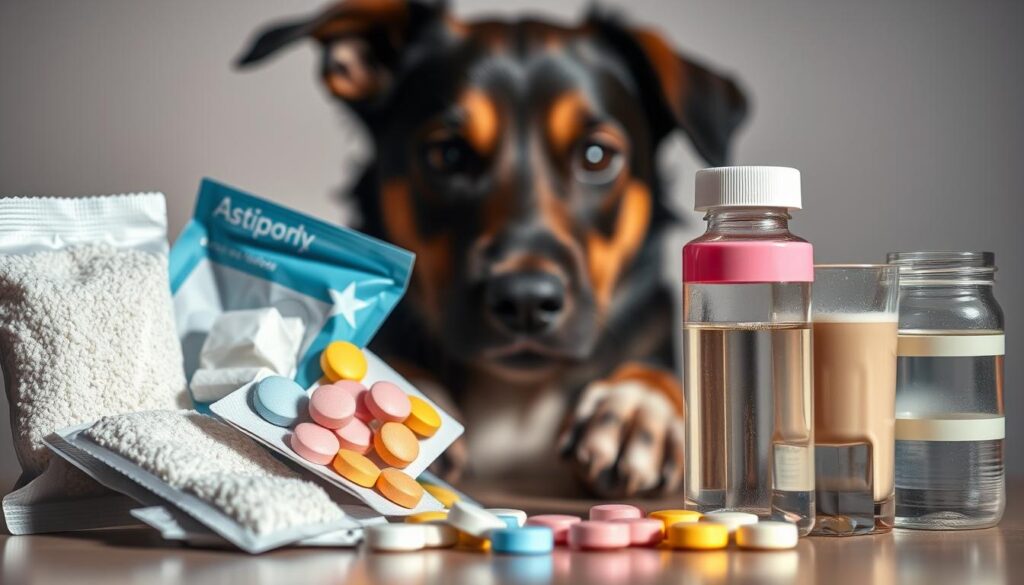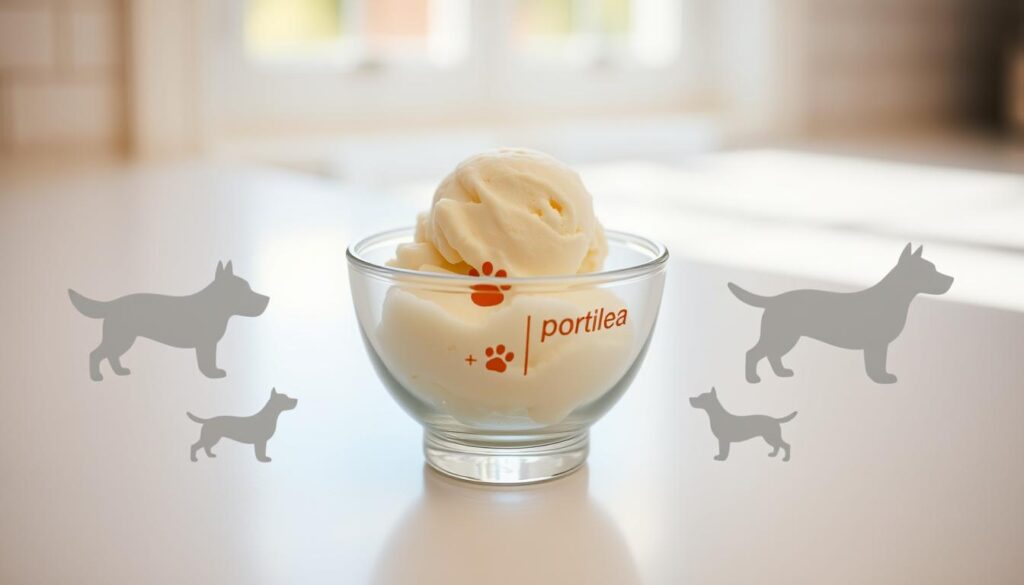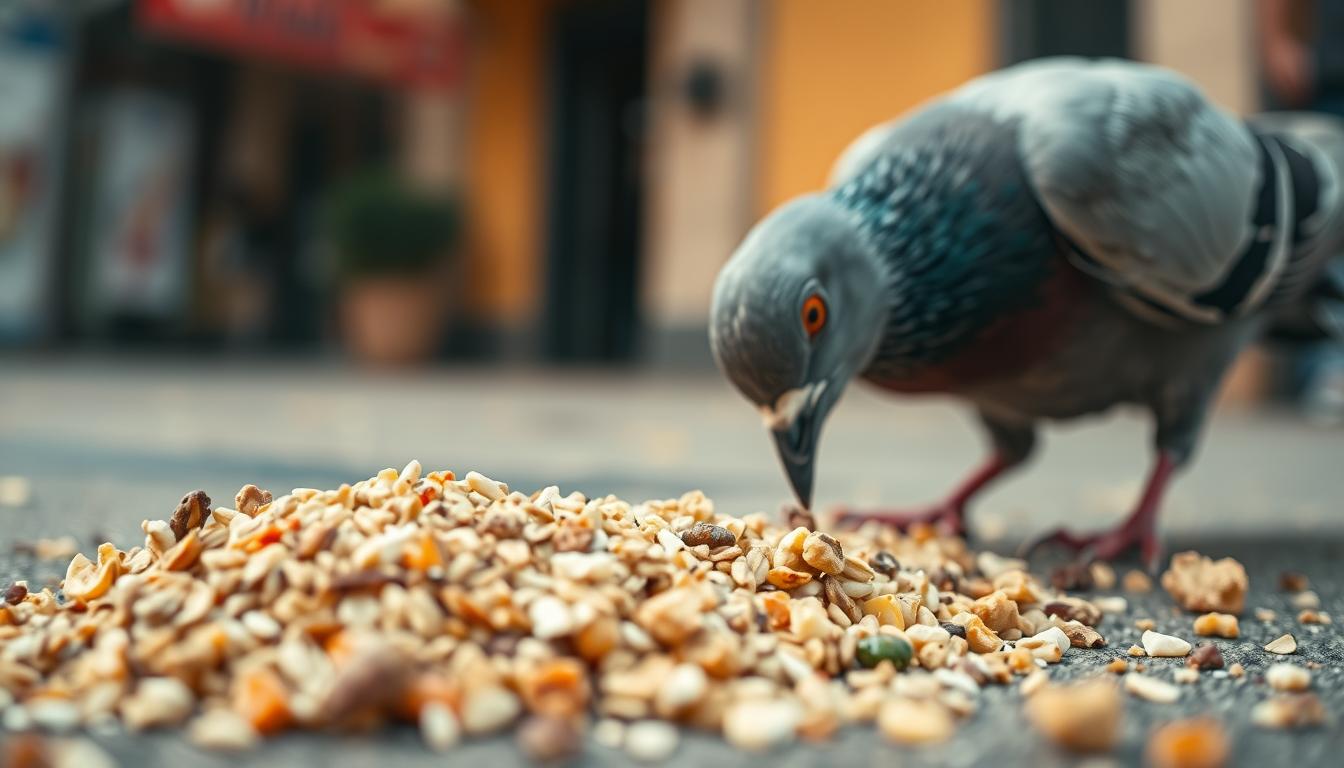Summer afternoons are perfect for enjoying vanilla ice cream. But, can you share it with your furry friend? As a pet owner, you might think those puppy dog eyes deserve a taste. However, the truth about dogs and vanilla ice cream is more complex than you think.
Every year, dog owners accidentally give their pets health risks by offering vanilla ice cream. It might seem safe, but it has hidden dangers. These dangers can seriously harm your pet’s health and well-being.
It’s important for dog owners to know the risks of certain foods. Before giving your dog vanilla ice cream, learn about three major health risks. These risks could turn a fun moment into a serious vet visit.
In this guide, we’ll explore why vanilla ice cream can be risky for dogs. Your dog’s health is in your hands. Make informed choices today.
Table of Contents
Understanding the Risks of Feeding Ice Cream to Dogs
Pet nutrition is key to dog care. Knowing the dangers of certain foods is vital for pet owners. Ice cream might seem like a tasty treat, but it can harm your dog.
Your dog’s digestive system is very sensitive. While treats like dog-friendly desserts are okay sometimes, regular ice cream is not. It has ingredients that can hurt your pet.
Common Ingredients That Harm Dogs
- Dairy products can cause severe digestive issues
- High sugar content leads to potential weight gain
- Artificial sweeteners like xylitol are toxic to dogs
- Chocolate-based ice creams are extremely dangerous
Immediate Signs of Digestive Issues
Watch for these signs after your dog eats ice cream:
- Vomiting
- Diarrhea
- Bloating
- Abdominal pain
Long-term Health Impacts
| Health Concern | Potential Consequences |
|---|---|
| Obesity | Weight-related joint problems |
| Diabetes | Insulin resistance |
| Digestive Disorders | Chronic intestinal issues |
“Prevention is always better than cure when it comes to your dog’s health.” – Veterinary Nutrition Expert
Remember, your dog’s nutritional needs are unique and require careful consideration. While treats are fun, your dog’s health should always come first.
Can Dogs Have Vanilla Ice Cream: The Complete Truth
Pet owners often wonder about safe human foods for dogs, especially treats like vanilla ice cream. The short answer is yes, dogs can have vanilla ice cream. But, it’s not recommended because of health risks.
The main concerns with giving vanilla ice cream to dogs include:
- High sugar content
- Potential lactose intolerance
- Risk of artificial sweeteners
- Unnecessary calories
Vets usually advise against giving vanilla ice cream to dogs. Most dogs can’t digest dairy well. Lactose intolerance is more common in dogs than many pet owners realize.
| Ice Cream Component | Risk Level for Dogs | Potential Health Impact |
|---|---|---|
| Sugar | High | Weight gain, dental issues |
| Milk | Medium | Digestive problems |
| Artificial Sweeteners | Critical | Potential toxicity |
“Not all treats that humans enjoy are safe for our canine companions.” – Veterinary Nutrition Association
If you want a cool treat for your dog, look for safe alternatives. Frozen low-fat yogurt or dog-friendly frozen treats are better. They keep your furry friend happy and healthy.
Lactose Intolerance in Dogs: What Every Owner Should Know
It’s important for pet owners to know about dairy and dogs. Many dogs have trouble with dairy, especially lactose intolerance.
Lactose intolerance is common in dogs. Unlike humans, dogs often don’t have enough lactase enzymes. This makes it hard for them to digest milk and dairy products.
Signs of Lactose Sensitivity
Knowing the signs of lactose sensitivity is key to keeping your dog healthy. Look out for these symptoms:
- Frequent diarrhea
- Abdominal bloating
- Excessive gas
- Vomiting
- Stomach discomfort
Breeds Most Affected by Dairy
Some dog breeds are more likely to have trouble with dairy. Here’s a list of breeds that are more sensitive:
| Breed Group | Lactose Sensitivity Level |
|---|---|
| Herding Breeds | High |
| Toy Breeds | Moderate to High |
| Large Working Breeds | Low to Moderate |
Alternative Dairy Options
If you want to give your dog dairy-like treats, try these options:
- Lactose-free yogurt
- Goat milk products
- Specially formulated dog milk replacements
- Calcium-fortified dog treats
“Know your dog’s dietary needs to ensure their optimal health and happiness.” – Veterinary Nutrition Expert
Always talk to your vet before adding new dairy products to your dog’s diet.
The Hidden Dangers of Artificial Sweeteners in Ice Cream

Artificial sweeteners can be very harmful to pets. Xylitol, found in many ice creams, is especially dangerous for dogs. It can cause a quick drop in blood sugar, leading to serious health issues.
“One small amount of xylitol can cause severe health problems for dogs faster than you might imagine.” – Veterinary Nutrition Expert
Pet food makers use artificial sweeteners to cut calories. But these additives can be toxic to dogs, leading to various health problems. It’s important for pet owners to know about these risks.
- Xylitol can cause sudden blood sugar drops
- Artificial sweeteners may trigger liver failure
- Symptoms can develop within 10-60 minutes of consumption
It’s key to know what’s in your dog’s treats. Always read labels and talk to your vet about safe foods for your pet.
| Sweetener | Risk Level for Dogs | Potential Symptoms |
|---|---|---|
| Xylitol | Extreme | Hypoglycemia, Liver Failure |
| Aspartame | Moderate | Digestive Upset |
| Sucralose | Low | Potential Stomach Irritation |
To keep your dog safe, watch out for harmful sweeteners. Make sure to keep ice cream and other foods with artificial sweeteners away from your pet. This will help avoid any health crises.
Safe Frozen Treats Your Dog Can Enjoy Instead
Summer heat makes your furry friend want something cool. Vanilla ice cream isn’t safe, but there are many tasty, dog-friendly desserts you can make or buy.
Finding the right frozen treats for your dog is easy. Homemade dog treats are a great way to keep your pup cool and safe.
Homemade Frozen Dog Treats
Making dog treats at home is simple. Try these easy recipes:
- Frozen yogurt pops with plain, unsweetened yogurt
- Frozen fruit purees using dog-safe fruits like blueberries
- Bone broth ice cubes for a savory option
Commercial Dog-Safe Ice Cream Options
Many brands now offer dog-friendly desserts. Look for products made just for dogs, without harmful additives.
- Puppy Scoops
- Frosty Paws
- The Honest Kitchen frozen treats
Natural Frozen Alternatives
Nature has great cooling options for your dog. Try these natural frozen treats:
- Frozen watermelon chunks
- Frozen banana slices
- Frozen carrot sticks
“Keeping your dog cool doesn’t mean compromising their health. With these creative alternatives, your pup can enjoy a refreshing treat safely!” – Veterinary Nutritionist
Always introduce new treats slowly and watch for allergies. It’s important to give frozen desserts in moderation to your dog.
How Much Ice Cream Is Too Much for Dogs?

When thinking about can dogs have vanilla ice cream, it’s important to be careful with how much you give. Dogs process treats differently than people. So, it’s key to keep portions small for their health.
Figuring out the right amount of ice cream depends on a few things:
- Dog’s body weight
- Overall health condition
- Age and activity level
- Existing dietary restrictions
Vets say treats should be no more than 10% of your dog’s daily calories. For a medium-sized dog, that’s about one tablespoon of vanilla ice cream as a special treat.
“Small portions prevent big health problems” – Canine Nutrition Expert
It’s also important to think about your dog’s breed. Smaller dogs need even less, while bigger dogs might handle a bit more. Always check with your vet before giving new treats.
| Dog Size | Maximum Ice Cream Portion | Frequency |
|---|---|---|
| Small Breeds (0-20 lbs) | 1 teaspoon | Rare treat |
| Medium Breeds (20-50 lbs) | 1 tablespoon | Occasional |
| Large Breeds (50+ lbs) | 2 tablespoons | Infrequent |
Keep an eye out for signs of upset stomach after giving new treats. If your dog vomits, has diarrhea, or seems tired, it might not be good for them.
Nutritional Impact of Ice Cream on Your Dog’s Diet
Pet nutrition is key to your dog’s health. Knowing how treats like ice cream affect their diet is important.
Ice cream is a big challenge for dogs’ diets. Its high calories can upset a balanced diet quickly.
Caloric Content Concerns
One serving of vanilla ice cream has a lot of calories. This can be too much for your dog’s daily needs. Here are some important points:
- Average dog treats should be less than 10% of daily calories
- One cup of vanilla ice cream has about 273 calories
- Small dogs need only 200-400 calories a day
Sugar and Fat Considerations
Ice cream’s sugar and fat can harm dogs. Too much can cause:
- Weight gain
- Potential pancreatitis
- Digestive problems
| Nutritional Component | Impact on Dogs |
|---|---|
| Sugar Content | High risk of obesity and dental issues |
| Fat Percentage | Potential trigger for inflammatory conditions |
| Caloric Density | Rapid weight gain potential |
“Responsible pet nutrition means understanding every treat’s long-term impact.” – Veterinary Nutrition Expert
Watching your dog’s diet and choosing the right food and treats is crucial. It keeps them healthy and avoids nutritional risks.
When to Call the Vet After Ice Cream Consumption
As pet owners, knowing when to get vet help is key. Not every ice cream mishap needs urgent vet care. But, some signs mean you should act fast.
“Prevention is always better than cure, especially when it comes to safe human foods for dogs.”
Look out for these warning signs that mean you should call the vet right away:
- Severe vomiting lasting more than 2-3 hours
- Persistent diarrhea with signs of dehydration
- Unusual lethargy or significant behavior changes
- Extreme abdominal pain or bloating
- Signs of allergic reaction like swelling or difficulty breathing
When you call the vet, have these details ready:
- Exact type of ice cream consumed
- Quantity eaten
- Time since ingestion
- Your dog’s current symptoms
- Your dog’s weight and breed
Vets say keep an eye on your dog for 12-24 hours after they eat something they shouldn’t. Quick action can stop bigger problems and keep your pet safe and healthy.
Seasonal Tips for Keeping Your Dog Cool Without Ice Cream
Summer heat can be tough on dogs, but there’s no need for ice cream. Simple pet care tips can keep your dog cool and safe in the heat.
It’s important to know how to keep your dog’s temperature right. Dogs can’t cool down like humans do. This makes them more likely to get too hot.
Essential Summer Cooling Strategies
- Provide constant access to fresh, cool water
- Create shaded outdoor spaces
- Limit midday outdoor activities
- Use cooling mats or vests
- Walk during cooler morning or evening hours
Safe Frozen Enrichment Activities
Hot days don’t mean your dog has to be bored or unhealthy. Try fun dog treats that cool them down and keep their minds sharp.
| Activity | Benefits | Difficulty |
|---|---|---|
| Frozen Kong Toys | Mental stimulation, cooling | Easy |
| Ice Cube Games | Playful hydration | Very Easy |
| Frozen Fruit Treats | Nutritious, low-calorie | Moderate |
Preventing heat stress is crucial for your dog’s comfort in summer. Always watch for signs of heat stress. Also, talk to your vet about what’s best for your dog’s breed.
“A cool dog is a happy dog!” – Veterinary Cooling Experts
Conclusion
Can dogs have vanilla ice cream? The risks are too big for any quick joy. Thinking about what treats are safe is key for your pet’s health.
Dairy, artificial sweeteners, and high-calorie foods can harm your dog. It’s tempting to give them your ice cream, but vets say no. They suggest dog-friendly treats instead.
Your dog’s health is the most important thing. Choose safe treats and talk to your vet to keep your dog healthy. Thoughtful care is better than risky foods.
Focus on your dog’s nutritional needs and their diet. There are many safe and tasty options out there. Don’t risk your pet’s health for a quick treat.
FAQ
Is vanilla ice cream safe for dogs to eat?
No, vanilla ice cream is not safe for dogs. Most dogs can’t digest lactose and may get sick. Also, ice cream has sugar and other bad stuff for pets.
What are the main risks of giving my dog vanilla ice cream?
Giving your dog vanilla ice cream can cause stomach problems. It can also lead to weight gain and serious health issues. This is because of the sugar and artificial sweeteners like xylitol.
How can I tell if my dog is lactose intolerant?
Look for signs like bloating, gas, and diarrhea after they eat dairy. Some dogs get sick fast, within 30 minutes. Some breeds are more likely to have this problem, so check with your vet.
Are there any safe alternatives to vanilla ice cream for dogs?
Yes! You can make safe treats with plain yogurt and fruits like bananas. There are also dog-safe ice creams available.
What should I do if my dog accidentally eats vanilla ice cream?
Watch for signs of sickness like vomiting and diarrhea. If it had xylitol or chocolate, call your vet right away. Make sure your dog drinks water and watch for any bad reactions.
How much ice cream is too much for a dog?
No amount of regular ice cream is safe for dogs. Even a little can upset their stomach. Treats should not make up more than 10% of their daily calories.
Can puppies have vanilla ice cream?
Puppies are very sensitive to dairy and sugar. Their stomachs are delicate and can get sick from ice cream. It’s best to keep them away from ice cream and stick to their regular food.
Are there any dog-safe ice cream brands?
Yes, there are brands like Puppy Scoops, Dogsters, and Ben & Jerry’s Doggie Desserts. They are made to be safe and healthy for dogs.




